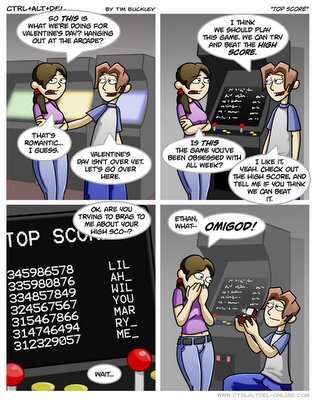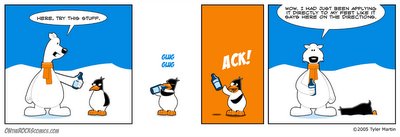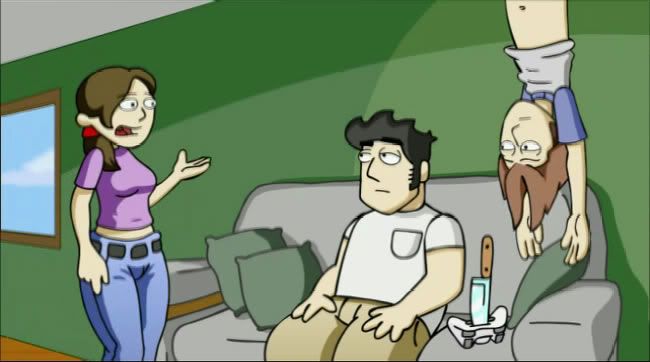
A look at some art change over at The Pet Professional.
Here's a topic I've been wanting to discuss at length for awhile now: webcomics changing their artists mid-run. The idea of a comic strip changing it's artist has been kind of a hot topic lately, with the whole announcement about Unfit wanting a new artist and the fact that the fans got to be part of the decision-making process (that and the fact that Scott Adams was captaining the effort, and he is nie unto a god in the world of comics these days).
Really, Unfit only got this much attention because of the rather curious way in which it went about looking for a new artist, with an open call and publicly viewable tryouts. The idea of comic strips (and comics in general, for that matter) changing artists is by no means something new. All the old-guard comic strips have done it. Blondie, Hi and Lois, Hagar the Horrible. Superhero comic books do it on a near-constant basis, and in some regard it is the lifeblood of the industry. What makes Unfit any different?
Well, one significant difference is that Unfit was actually looking to change its artistic style. Not a bad idea, really, considering Unfit is about the ugliest mofo on the comics page right now, but this is a relative oddity. Most of the time when an old comic starts being captained by a new artist, the goal is to make the new artwork as close as humanly possible to what was already being done so as not to alienate the fanbase. Even in superhero comics where this restriction is loosened somewhat, generally the artist tries to keep to the original design of the characters fairly closely on the whole, with most variations being on the "cosmetic" side of things. Unfit underwent a complete and total overhaul, and will in no way resemble the strip it used to be. And it'll be interesting to see how it pans out.
Which brings us to the discussion of webcomics changing artists. And it's important from the outset to understand some fundamental differences between when webcomics change artists and when more traditional comics change artists. First of all, when a webcomic changes artists, it is universally as a result of a writer/artist pair splitting up, with the writer wishing to continue the project and the artist wishing to move on to something else. It's interesting to note that if this split happens the reverse way (writer leaving artist), in almost all cases the artist will simply pick up the writing duties and continue on solo. But when the artist leaves, it is almost never the case that the writer will begin drawing the project. This is a rather interesting distinction between writers and artists, that artists seem to be able to pick up writing skills as they go along, while most writers fail to pick up any artistic skills. My guess is that this is because the process of developing the art for a story teaches someone a lot about storytelling, while describing the desired art to accompany a story teaches someone practically nothing about drawing.
But the point is that when an artist leaves the writer holding the ball, in almost all cases the writer can't run with it by himself. He needs a new artist to help him out. So he'll put out an open call for anyone looking for a project, advertise it around a bit, and try to find someone new who's willing to take on the "art monkey" duties. We've seen this happen in a few webcomics recently, notably Pet Professional (which I demonstrated above) and Gossamer Commons. And because of the limited pool of artists available willing to devote hours of their time for little or no compensation, and the fact that any artist willing to do that is typically looking to develop their own style as opposed to strictly copying someone else's, the comic ends up looking different. Not necessarily fundamentally different (you can still tell the Pet Professional is the Pet Professional between the two panels above), but different enough that the structure of the comic has changed on a somewhat fundamental level.
And, based on what I've seen, when a webcomic changes artists, it is generally detrimental to the health of that webcomic.
Now, I'm not quite sure why this is. I mean, even when a webcomic doesn't change artists its art typically changes quite a bit over time (see: Goats, Penny Arcade, and Questionable Content, to name a few), and people seem to be more than willing to stick with it. When a writer changes there may be some rocky times, but some strips have proven more than able to come out on top. So why is it that when an artist changes, a webcomic just can't seem to recover? My guess is that the fans develop more of an emotional attachment with the artist, because no matter who's in the background pulling the strings, it's ultimately the artist's work that we see on the page every day. The artist's contribution is staring us right in the face, while the writer's contribution hangs nebulously in the background.
Another problem could be with the different visions of the project. Typically when a writer and an artist pair up, they bring a single, unified vision to their project. The writing and the art fit together perfectly because the writer and the artist specifically joined up together for that reason. When a new artist is added to the mix, he brings his own vision to the project, and there is frequently a clash between his vision and the old artist's vision, and therefore a clash between him and the writer, who shared the vision of the old artist. And reworking those visions into something cohesive and unified is an extremely difficult process, which can ultimately end up severely blunting both the artist and the writer's desires and result in a much more mediocre end product. I speak this from bitter experience, as this sort of conflict is what ultimately deep-sixed my first webcomic project, Gideon D. Ragon, Private Eye, when I was forced to seek a new artist after my original one ran out of free time. The new artist I found just didn't have the same vision for the project that me and my old partner had, and in our attempts to compromise with each other into something workable we ultimately killed the project.
Now, this is not to say we couldn't have a strip get a new artist and see it flourish. Heck, I think both Gossamer Commons and Pet Professional have a shot (although, in both cases I preferred the old artist. But is that just because I had an attachment to them?). I'm just saying it's really hard. Say Gabe decided to suddenly leave Penny Arcade. Would Tycho be able to find a new artist? Heck yeah. Would the strip still be good? I think Tycho is a smart enough guy that yes is a safe answer to that question. Would it be as popular? At first, definitely not. We've come to love Gabe's take on the characters over the years, and any new artist, unless he was able to exactly reproduce Gabe's work, would be seen as worse than Gabe, no matter how talented he was. It would be worse because it would be different, and what we want is more of the same. But ultimately, I think the quality would speak for itself and Penny Arcade would be able to reestablish itself on the top of the pile. I think success stories can happen.
So if you find yourself in the situation with your webcomic that you have to change artists, think about the ramifications. It might be better for you to find a new artist and start a new project with him, rather than trying to keep a burgeoning property alive. You might even want to start a new project with yourself as the artist and develop your own artistic skills so you don't ever find yourself in this situation again. This is not to say that you should give up on your original vision, you might get lucky and find another artist who shares it with you. But you'll have to realize that you'll be starting from the bottom again, and it's going to be another long climb up to where you were when your other artist left. So think about what you'd rather do.








